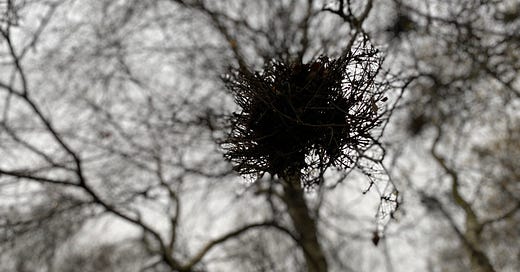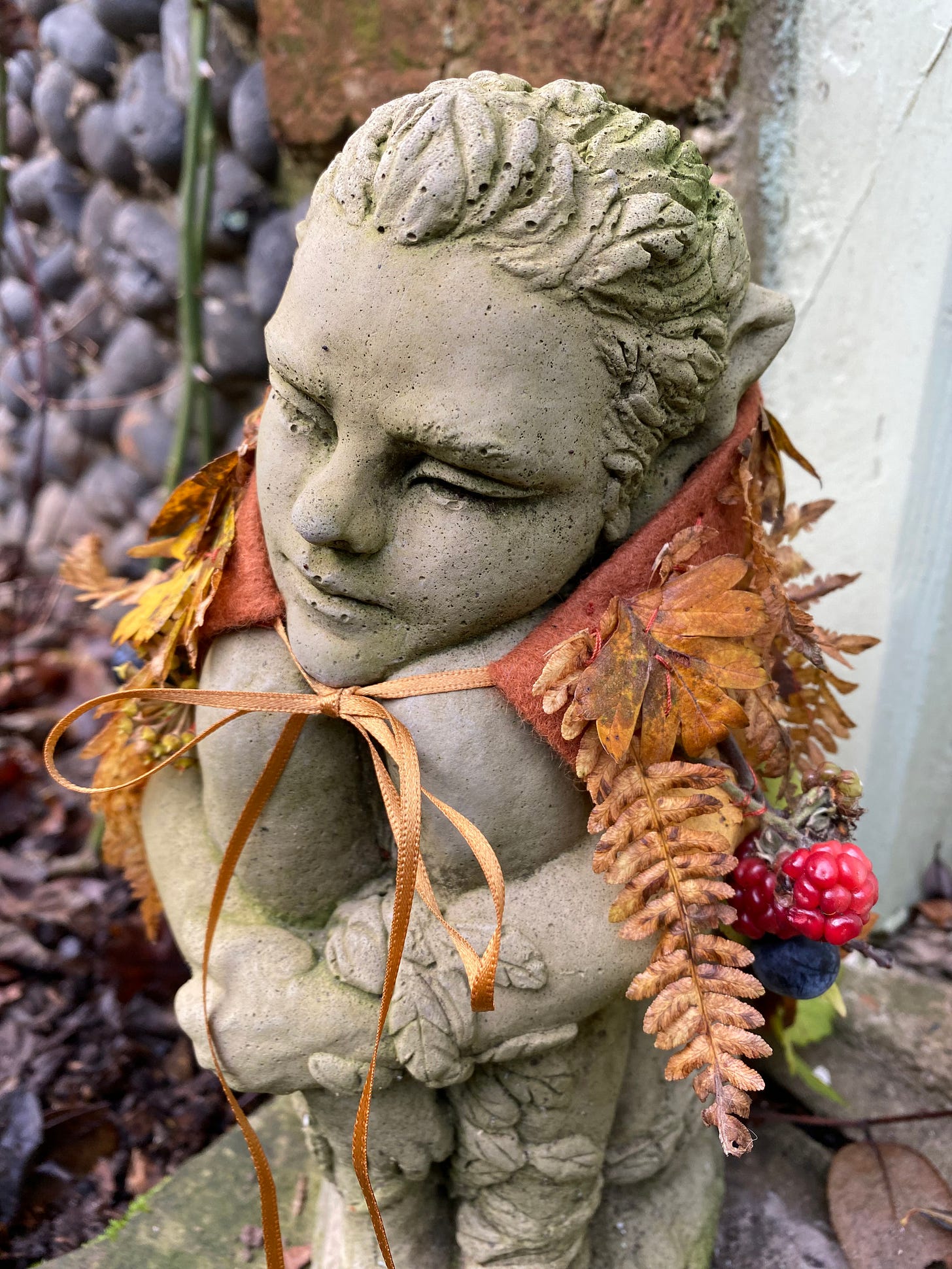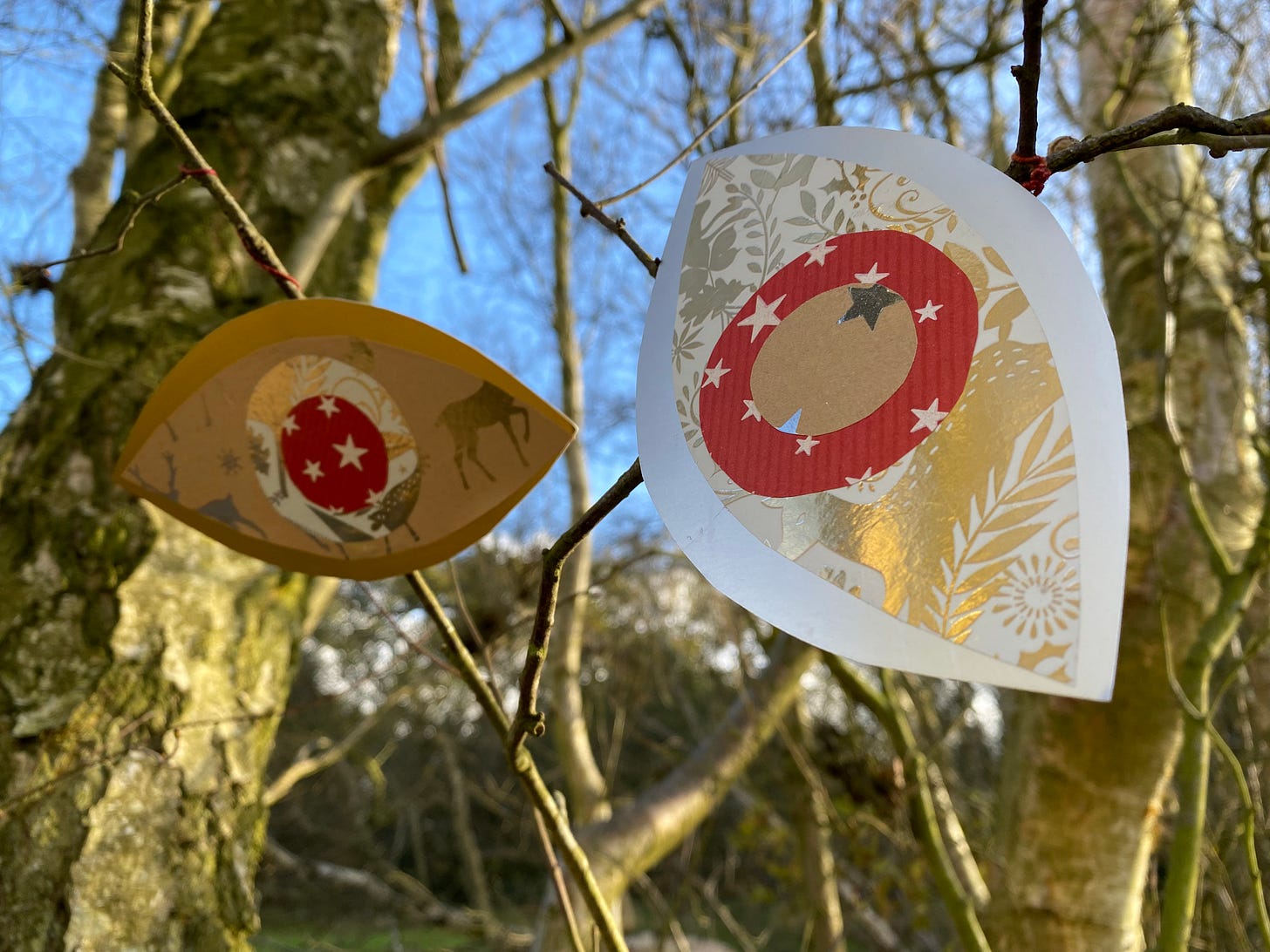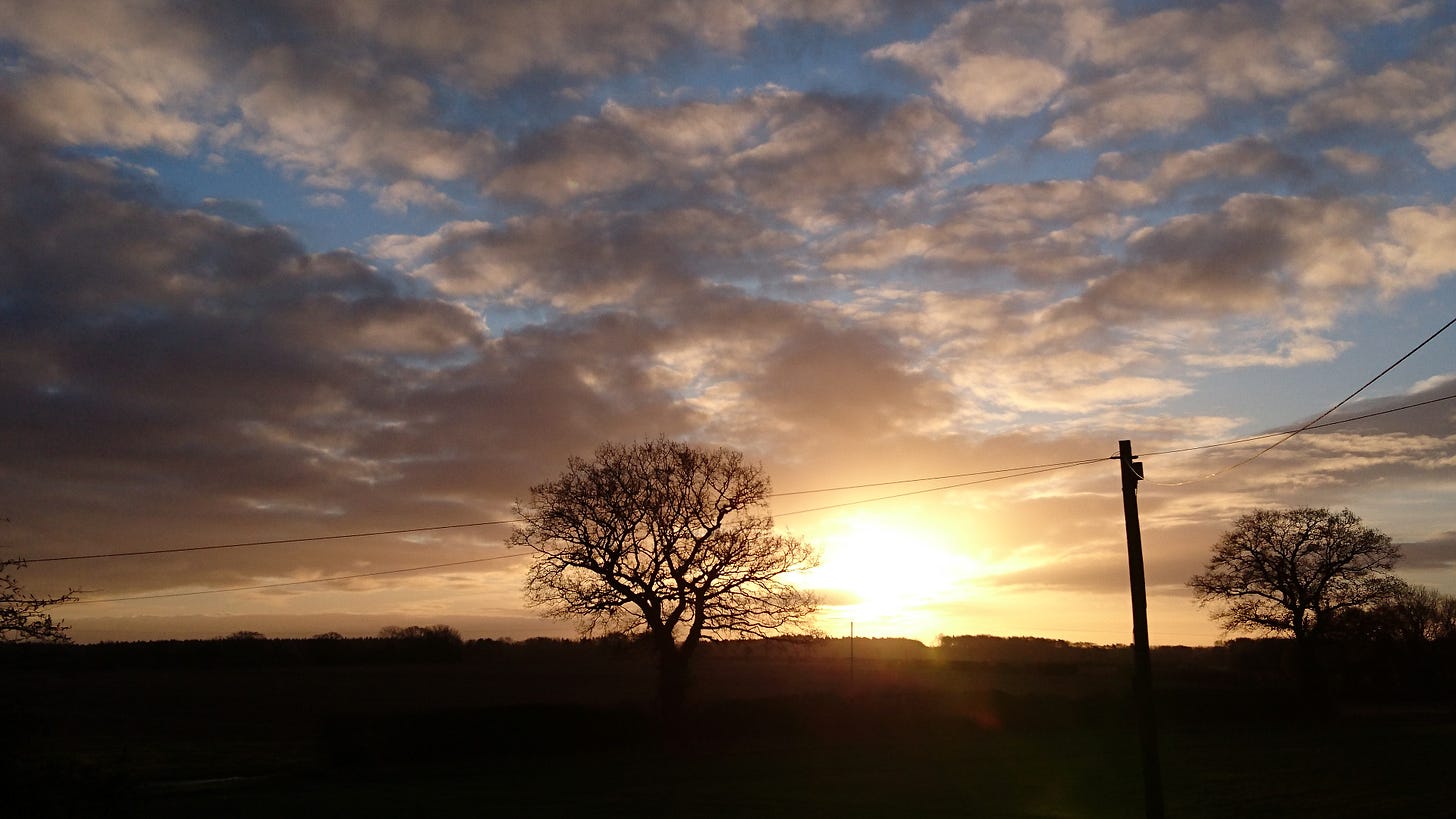Witches’ broom in Crow Wood
Cold Moon, Long Nights Moon, Moon Before Yule, Oak Moon, Bitter Moon. Frost Moon. What will you choose to call the December Full Moon? Is there something you notice especially at this time of year? I rather like Bitter Moon, even though it’s a little melancholy. But looking around me here at The Old Shop, I think I’d have to choose between Muntjac Moon (they’re always present but have taken on their winter colouring) and Birch Track Moon.
A walk through Acorn Wood always reveals something of enchantment even on a cold and grey day when it’s tempting to stay in and light the stove. The blustery wind has sent many more oak and birch leaves fluttering down since my last visit. I crunch through the deep and springy carpet, surprised by the occasional crack as my wellies land on a stick.
With most of the birches now bare or nearly so, the weird, chaotic forms of Witches’ Brooms seem to stare at me as I pass. I love their wildness, the way they are steadfastly themselves and refuse to be drawn into the delicate tracery expected of ‘nice’ winter birch twigs.
As I walked I began to wonder about witches’ brooms. What causes them? Do they grow on other trees, or just birches? It turns out that the term ‘grow on’ is not really right, as they are actually part of the tree itself. And, they're caused not by a single entity but by lots of different things that can stress the tree, including fungi, mites, aphids, nematodes and viruses. Since brooms were traditionally fashioned from bundles of twigs and since it was assumed that witches were responsible for anything weird, these anomalies became known as witches’ brooms.
Although they’re linked to various tree species they seem to be commonest in birch, especially around The Old Shop where I’ve never seen them on anything else. And birch brooms are usually caused by a specific fungus called Taphrina betulina (which, incidentally, sounds rather like a Harry Potter style invocation when you say it out loud!).
The broom, a dense mass of shoots growing from a single point, begins when the growth of a lateral bud ‘loses control and causes multiple stems to form in a tangled, disorganised manner’. Apparently it takes many years to create big brooms; they become wilder and more anarchic year on year. I don’t know about you, but that sounds like something I can empathise with ;)
Depending on where you do your research, they are seen as a troublesome abnormality or as an interesting feature. Some gardening sites describe them as deformities that have to be ‘dealt with’ while the Woodland Trust recommends that they are left in place as a natural occurrence and says of one of the woodlands that they manage, ‘several trees are developing a lovely spread of witches brooms.’ Even the most draconian sources have to grudgingly admit that they are good for wildlife, providing a nesting habitat for birds and mammals.
The presence of magical mistletoe on a tree can actually cause it to develop witches’ brooms. Doubly enchanted!
The Sprite Childe wearing his cosy new cloak of felt and hedgerow finds from along the lane. A present from a lovely friend who also loves the woods and heath.
M U S I C F O R M I D W I N T E R
What do you listen to at this time of year? In early December it feels to me too early for the Christmas classics but I love the sense of anticipation that certain melodies evoke. The word Advent, I discovered, is Old English, from the Latin adventus ‘arrival’ but ultimately from advenire, ’to come’. Which is, perhaps, why I gravitate to music that has that sense of magical hush before the curtain rises and sounds festive without being overtly ‘Christmassy’.
When my children were little, and indeed to this day, there was a family tradition of playing two special CDs while wrapping presents, writing cards, making mince pies and especially decorating the Christmas tree.
My girls still keep up the ritual in their own homes and have said it wouldn’t be Christmas without it.
Since those early days my playlist has expanded a bit and I thought I would share my favourites here in case some of them are new to you and you would like add to your own Advent traditions. I’ve given a link to the CD where it still exists, and several are available for unlimited free streaming.
I’ve started with some for early Advent - they get more and more festive as you go down the list. The last two are the stars on the top of the Christmas tree. And maybe you’ll (I resisted saying ‘Yule’ haha) feel the same way.
Gothic Voices - The Voices of England and France Vol 3
https://www.amazon.co.uk/Spirits-England-France-Gothic-Voices/dp/B002HESQK8
Rose Consort of Viols - Dowland: Consort Music and Songs
https://www.amazon.co.uk/dp/B0000014DF/ref=dm_rwp_pur_lnd_albm_unrg
The Cardinall’s Music - Byrd Propers for Christmas Day
https://www.amazon.co.uk/Byrd-Propers-Christmas-Day-William/dp/B000007NEI
Richard Hickox - Ralph Vaughan Williams: Fantasia on Christmas Carols
British Composers - Ralph Vaughan Williams: Fantasia on Christmas Carols
Maddy Prior and the Carnival Band - A Tapestry of Carols
https://www.amazon.co.uk/dp/B0000245U6/ref=dm_rwp_pur_lnd_albm_unrg
* Martin Best Ensemble - Thys Yool *
https://www.amazon.co.uk/dp/B073FD5ZRX/ref=ntt_mus_ep_dpi_1
* Magpie Lane - Wassail: A Country Christmas *
Wild eyes by the stream - preparing the stories for Birch Track, last year’s Midwinter candle
S T L U C Y
Eyes glint between the trees, twisting and turning, bright reminders of the sun’s return at Midwinter.
Eyes everywhere on the Birch Track; watching, guiding, protecting. Fairytale eyes.
The sparkle of a wild creature’s eyes in the dusk.
Lucy light, Lucy light
Shortest day and longest night
St Lucy’s feast day is 13 December. Before the Lost Days it was close to the Solstice which explains this ancient rhyme. Ablaze with light on the darkest night, her crown of candles is a prayer to the sun. If you look for a medieval image of her, you may see her with her eyes on a plate or with fire in the palm of her hand, calling back the power of the light.
A year ago, I made a video about St Lucy and her wild alter ego Lussi. You can see it here:
While doing my research I came across several recipes for Lussekatter, traditional Swedish buns eaten on St Lucy/Lucia’s Day. Saffron turns them golden, and they are coiled into S-shaped sun-wheels, circling the Solstice with their raisin eyes.
Sometimes it’s hard to choose between similar new recipes for these fleeting feast days when you want to be certain that the baking will turn out well. Then I thought, if you know that a recipe works perfectly and is delicious, why not adapt it to reflect the festival you’re celebrating?
So, here is a version of the chocolate and hazelnut cookies that I often make, and love. I’ve chosen almonds as they turn golden when toasted and give the right crunch to the cookies, and instead of chocolate I suggest fiery ginger, dried cranberries or goji berries to represent Swedish lingonberries and a sprinkle of the caraway seeds that are so often found in Nordic baking.
See what you think - and please let me know how you get on if you make them!
S T L U C Y ’ S B I S C U I T S
50g coconut oil
150g coconut sugar
150g plain flour (I use gluten free)
1 tsp baking powder
Good splash of almond milk (or other milk)
90g blanched almonds, toasted until golden
70g crystallised ginger, chopped, or a mixture of ginger and dried cranberries or goji berries
2 tsp caraway seeds
A few saffron strands (optional)
Oven 170c, fan setting. Line a baking sheet or two with baking parchment.
Chop half the toasted almonds into chunks and grind or process the other half into a flour.
Melt the coconut oil and allow to cool a little.
Place the coconut sugar in a mixing bowl and stir in the coconut oil.
Add flour, almond flour and baking powder then blend in the almond milk. Add a bit more flour if you make it too wet (voice of experience).
Stir in the chopped almonds and crystallised ginger, goji berries, cranberries, caraway seeds or any combination of these.
Leave to rest for five minutes.
Shape the mixture into 12 balls, flatten slightly and space well apart on baking sheets.
Bake for 12 - 14 minutes until golden. They will still be soft but will crisp up as they cool, so leave them for at least half an hour before being tempted to taste. I keep mine in the fridge. They are firm on the outside with a lovely fudgy centre.
And the saffron? As Lussekatter always contain saffron, if you have some and want to be traditional you could infuse a few strands beforehand in warm almond milk.
The sun, the oak and the notch - from my winter window 2017
A S T O R Y F O R A D V E N T
Until I was widowed on Christmas Day 2016 I had never lived on my own, even for one day. Now it was November 2017 and a new winter was spreading its fingers over the thinning hedgerows and stubble fields. How unsettling it was to be gently pushed through the door of this unfamiliar place with its vast open fireplace, storage heaters, temperamental plumbing and the 14 hunting prints that graced the walls of the sitting room.
But the bedroom, now that had something familiar about it. The sunrise. Each morning I gazed towards the ancient oak tree to observe the sun’s steady progress to its Southern grounds. A distinctive notch in the distant hedge line always drew my eye. I never tried to find it on the ground. In fact I have a feeling that it would have been akin to searching for the pot of gold at the foot of the rainbow (which of course, as a child, I fervently believed in.)
This notch became my marker, the first thing after the oak tree that my eyes would seek out each day. With no cairns, chambered tombs or stone circles to pin down Norfolk’s celestial alignments it is this kind of tricksy feature that has to stand in on their behalf. Tricksy, because a hedge can be hacked down; an ancient tree felled or toppled by gales. Even telegraph poles, roped in as honorary natural features, can be moved on the whim of an electricity company.
Sometimes I rose earlier than the sun, and would watch for the moment when the fireball suddenly filled the hole in the hedge completely, swelling and pushing upwards until, like a shimmering sphere breaking free of a child’s bubble-blowing toy, it sailed upwards and away.
Often that year, the heavens were clear and the colours vivid. Then, the criss-crossing of aeroplane trails would stir up the skies, leaving runic inscriptions that melted teasingly away just as you knew you were on the verge of understanding something hugely important. Sometimes mist hung so low that even the oak tree wore a great woollen hood over its eyes. Other days the sparkle of frost, shot through with lavender and apricot, turned my morning world to fairyland.
The previous year, as a distraction I had posted a ‘shiny something’ on Facebook for every day of Advent. At least, until towards the end. Sometimes it was an image, sometimes a little story or observation. This year was very different in so many ways, and most of them sad. I decided I would take a photograph of the sunrise from the bedroom window every morning and pair each one with an image from the same day the year before. An act of remembrance - my husband had loved Norfolk skies - but also an acknowledgement that my adventures would continue on behalf of us both.
My borrowed east-facing window taught me that every day tiptoes in as its own unique self, and once greeted will willingly share its stories.
I watched and wondered as brilliance moved along the horizon, quivered on its pointes in the notch and then drew itself on towards the oak tree, throwing its bare branches further and further into fiery-rimmed silhouette.
Some days the magic called so beguilingly that my shutter would click and click. On other mornings a heavy veil was drawn across the dawn, cutting off the stage set from my hungry eyes. I was bereft. Still, I knew that behind the curtain the tulle-and-sequin-clad dancers continued to perform unending feats of wonder and dexterity.
Advent passed, and with it the rationale for the daily photograph, but now the necessity was as fierce as that of any addiction. I would run for my phone whenever a sky stopped me in my tracks as I climbed out of the now-familiar bed and padded across to the window. More than this, I had to be present to the drawing away, the ebbing of the tide. The sun in its glory, pulled back through the notch by its slow, unstoppable journey to the North.
And the promise of Summer.







That was a most beautiful and wonderful read. I learn so much from you Imogen.
You lighten the darkest days with your knowledge and peaceful words
I always thought of witches brooms as something completely different but not the idea banded around.
Thank you for making all seasons right and proper.
It reminded me that I did move on and hard to believe it would happen. Or that I would remarry an equally lovely person.